written and photographed by Mary L. Peachin
Apr 1997, Vol. 1 No. 7
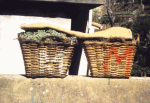 Florence, Greve, Volterra and Sienna appear like fortresses in the hillside towns of Tuscany in central Italy. Two-lane roads weave between these charming towns winding through fragrant olive orchards and vineyards laden with Chianti grapes. Mid-September is almost harvest time. The aroma of garlic sizzling in virgin olive oil wafts across cobblestone streets. We peddle faster to our next destination and our next meal.
Florence, Greve, Volterra and Sienna appear like fortresses in the hillside towns of Tuscany in central Italy. Two-lane roads weave between these charming towns winding through fragrant olive orchards and vineyards laden with Chianti grapes. Mid-September is almost harvest time. The aroma of garlic sizzling in virgin olive oil wafts across cobblestone streets. We peddle faster to our next destination and our next meal.
Bicycle touring company Ciclismo Classico knows Italy! Our guide, Mauro Rugiero, part-time lawyer and owner of the company, was so passionate about his love for the food, wine, and culture of Tuscany, we would have followed him anywhere.
Flying non-stop on Alitalia Airlines from Los Angeles to Milan, we decompressed from jet lag at a quiet hideaway, Ranco di Sol. This Relais & Chateaux luxury hotel is located about 35 miles north of Milan. The eight suites of this small hotel in Ranco, Italy overlook Lago Maggiore.
Our first days were spent lazily cruising Lake Maggiore by hydrofoil boat or ferry. We visited the islands of Isola Bella and Isola di Pescatori. We walked the cobblestone streets of Stresa. Frequent expresso stops in tea gardens covered with ripened grapes trestled overhead provided the opportunity to watch boats cruising on the lake.
Ciclismo Classico begins their Tuscany tour in Florence with the final destination being the island of Elba. Our train ride from Lake Maggiore to meet the group in Florence required three train transfers plus a metro ride to Milano Centrale. Italian trains usually operate on a timely schedule. It amazed us that we were able to find the right track and direction with only several minutes to spare between each connection.
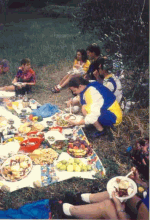 Our Ciclismo meeting place in Florence was the centrally located Pension Silla. After settling in our hotel room, we joined the many tourists as they wandered through the many shops in the rain. There were people jams as tourists squeezed between the parked cars lining the narrow streets of the shopping district.
Our Ciclismo meeting place in Florence was the centrally located Pension Silla. After settling in our hotel room, we joined the many tourists as they wandered through the many shops in the rain. There were people jams as tourists squeezed between the parked cars lining the narrow streets of the shopping district.
As the afternoon past, church bells chimed welcoming local parishioners to Mass. Tourists streamed by the replica of Michelangelo’s sculpture of David, the Pitti Palace, the Major Duomo Cathedral and the Ponte Vecchio bridge across the Arno River.
Our group of 20, plus three guides, met in time to walk to dinner at Leo in S. Croce. It was our introduction to Ribolleta, a typical working class Italian soup made with stale bread and topped with a splash of virgin olive oil.. We “carbo-loaded” for our next day of bicycling. After the soup we ate pasta, melon and proscuitto, salad, and tiramisu, an Italian favorite, for dessert.
Ciclismo drove us by van to the village of Imprunete, a suburb of Florence. We could look back at the city of Florence with the winding Arno River flowing through it. The village square of Imprunete was the beginning of our ride to Greve. After riding about twenty miles through vineyards and olive groves, we stopped at a small trattoria for lunch. Our palates were introduced to a wide noodle pasta made with chocolate. The Ribolleta soup served was Sopa di Papa, or the “blood of the Pope.” It was made with tomatoes and bread, wonderfully seasoned with a splash of olive oil. Were we eating between rides or riding between scrumptious meals?
Prior to arriving at our hotel in Greve, we stopped at a Chianti Classico vineyard and winery named Villa Calcinaia. Count Nicole took us on a tour of the villa concluding with a wine-tasting.
Our hotel located outside the town of Greve, DA Omega, was somewhat lacking in both comfort and hospitality. It did, however, offer music with its typical Tuscan cuisine dinner.
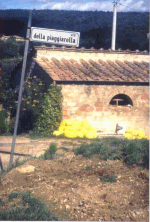 Greve to Siena was a hilly 50-mile ride. Passing through the center of Greve, we stopped to buy Chianti Classico bicycle jerseys at a bicycle shop. Wearing the symbol of the black rooster, the Gallo Negro, made us feel a part of the Tuscan culture. Our route included a stop in the villages of Radda and Panzano. Some riders took a detour to visit the Castello(castle) di Brolio.
Greve to Siena was a hilly 50-mile ride. Passing through the center of Greve, we stopped to buy Chianti Classico bicycle jerseys at a bicycle shop. Wearing the symbol of the black rooster, the Gallo Negro, made us feel a part of the Tuscan culture. Our route included a stop in the villages of Radda and Panzano. Some riders took a detour to visit the Castello(castle) di Brolio.
We spent two days in Siena at the Hotel Chiusarelli. The layover day gaveus the opportunity to walk the cobblestone streets of this medieval walled city. We toured the Piazza del Campo when Italy’s most famous horse race is held. The races, held annually on July 2 and August 16th honor patron saints. The winning horse, with or without the bareback riding jockey still astride, carries the pride of the region they represent until the next annual ride.
The Duomo, or cathedral, in Siena is magnificent with its frescoes, sculptures of more than one hundred pope’s heads, and mosaics. The architecture is a combination of Gothic and Romanesque.
Our next ride was approximately 50 miles from Sienna to Volterra. It was the most challenging ride of our trip. Volterra, a hillside fortress founded by the Medici family, required a six mile climb with headwinds blowing approximately 40 MPH. Only the “hard-core” riders rode the entire route to Volterra. The rest of us “hitched” a ride in the van.
Another layover day gave us time to enjoy Volterra. We had the option to use our “day of rest” to ride to San Gimignano. This walled city is renown for its alabaster.
The ride from Volterra to Elba included travel by bicycle, train, and ferry. A wrong turn in Piombino and, fortunately for us, an unusually, late train arrival gave us one minute for boarding.
It was a short train ride to transfer to the ferry to Elba. After arriving on the island, we bicycled 15 miles to the Hotel Bahia. Our eight day tour had covered a total of 230 miles and 27,000 feet of climbing. Who knows what our caloric intake or chianti consumption had been. When Ciclismo shared with us our ride climbing elevation, we all felt proud of ourselves.
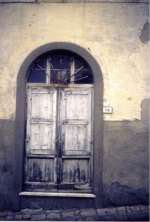 Our final day of bicycling was spent touring the western part of the Island of Elba. We bicycled through the towns of Secchetto and Cavoli. The road followed the coast line. We dodged rain storms taking time at the lookouts from the cliffs to gaze at the Mediterranean. One final push, a quick swim in the ocean, and it was time to say arriverderchi to our bicycles.
Our final day of bicycling was spent touring the western part of the Island of Elba. We bicycled through the towns of Secchetto and Cavoli. The road followed the coast line. We dodged rain storms taking time at the lookouts from the cliffs to gaze at the Mediterranean. One final push, a quick swim in the ocean, and it was time to say arriverderchi to our bicycles.
Boarding the ferry back to the Italian mainland at Piombino, we left the group to catch a train to the port of Livorno. In Livorna, we rented a bright violet Y-10 Lancia. We named the little car “Junior”. The car had a security code that was required to start the ignition. We couldn’t imagine anyone wanting to steal “Junior”. With the excellent train service, driving in Italy was not our preference. But the car allowed us the flexibility to visit Cinque Terre, the fishing villages of Liguria, en route to Milan.
Indulging ourselves after eight days on the bicycle, we stayed overnight at another Relais & Chateaux hotel, Il Bottacio. Originally an 18th century olive mill, the decor was exquisite. Filled with antiques, the dining room surrounded a reflection pool. We stayed in a suite larger than some homes. Located in Montignoso, our room offered a distant view of the south end of the Italian Riviera.
“Junior” was suffering from some minor scrapes. We renamed the car “Junior al Dente”. Some of the streets in the region of Liguria are not much wider than sidewalks. The streets in the fishing villages of Cinque Terre do not allow car traffic.
The five villages of Cinque Terre overlook the Ligurian Sea. Locals and touring companies hike the trail linking the villages. There is also a small train shuttle and a water ferry for travel between villages. In addition to fishing, these Italians also grow grapes. They were busy harvesting the grapes using cabled trams to carry the grapes up the hillside of the steep terraced vineyards. We visited the villages of Manarola and Vernazza before we took the long, steep, and sometimes unpaved, hairpin-curved road to the fishing village of Sestri Levante.
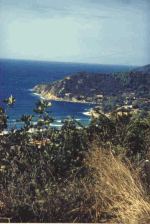 The Helvetia Hotel overlooked the Gulf of Di Riva Trigoso. The quiet, charming hotel was located at the end of the street in the Bay of Silencio.After two weeks of dodging rain drops, a day’s downpour finally caught us during a drive to Portofino, the ritzy area of the Italian Riveria. Bad weather during the off tourist season spared us the traffic gridlock usually encountered on the road to Portofino. More hairpin turns with dark tunnels followed the magnificent coastline through olive orchards and luscious rain forest.
The Helvetia Hotel overlooked the Gulf of Di Riva Trigoso. The quiet, charming hotel was located at the end of the street in the Bay of Silencio.After two weeks of dodging rain drops, a day’s downpour finally caught us during a drive to Portofino, the ritzy area of the Italian Riveria. Bad weather during the off tourist season spared us the traffic gridlock usually encountered on the road to Portofino. More hairpin turns with dark tunnels followed the magnificent coastline through olive orchards and luscious rain forest.
Leaving Portofino, the climbing elevation of the road provided a view all the way to the Gulf of Tigullo. The valleys were filled with vineyards and olive groves. Ca` Peo, a small, family owned farmhouse and restaurant, located near Chiavari, offered the finest meal we enjoyed in Italy.
Fortunate to be served without the required prior reservation, we had a leisurely lunch at one of twelve tables. Ca`Peo offered the finest in gourmet dining, decor and service. We were still digesting our delicious lunch that evening as we walked down the cobblestone streets back in Sestri Levante. We ate a light pasta dinner at a tratorria named Polpo Mario.
Milano is a cosmopolitan city, a combination of Paris and New York. There are beautiful shops, the third largest cathedral in the world, and the La Scala opera. The Vittorio Emanuele galleria or shopping mall is located across from the Duomo (cathedral).
Purely by luck, we wandered into a charming pizzeria named “50” for lunch. The Hotel Corrobio, a five minute walk from the Duomo and major shopping areas, was the perfect hotel to end our visit in Italy.Italy, a tranquil beginning in Lake Maggiore, then bicycling from Florence to Elba, driving through Cinque Terre north to Liguria and ending our trip in cosmopolitan Milano. It was an adventure with a wonderful taste of Italy. Literally!
Sculling in Santa Fe
“Feather your sculls, square those oars, don’t catch a crab”! Translated, it means “stabilize the oars gently on the water, drop them squarely, avoid having the oar angle catch. The water should flow over the oar during the stroke” This is the new vocabulary for the increasingly popular new recreational sport of sculling (rowing).
Whiterock Canyon, the upper extension of Lake Cochiti, borders scenic Bandelier National Park. Mark Miller, owner of Rowest, in Santa Fe, New Mexico, uses this setting for instructing beginning students. Experienced rowers have the ability to take extended eight day trips. Sculls have the capacity to carry food, wine, camera and other gear.
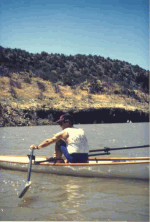 Mark, a certified coach, has won many national and international competitions. Rowest tours are planned as day trips with the central base being Santa Fe, a forty five minute trip from the Lake. The weight of the scull is not conducive to being portaged like a canoe.
Mark, a certified coach, has won many national and international competitions. Rowest tours are planned as day trips with the central base being Santa Fe, a forty five minute trip from the Lake. The weight of the scull is not conducive to being portaged like a canoe.
At the Olympic level, the sport appears easy. Rowing is technical and requires synchronized team work when there is more than a single rower. Recreational touring in single or two people sculls requires a great deal of coordination. Sculls, in lakes and rivers without rapids, can cover more distance than kayaks. After learning the basics, the rower can do fifteen- minute miles. This mileage affords the opportunity to view a lot of scenery.Rowing in a touring boat called a whery, the scull is 20-feet long, and weighs 140 pounds. A touring scull is more stable than the 27-feet, 40- pound variety used by Olympic racers. Touring sculls are made for cross country touring down placid lakes or rivers.
Carbon oars called sculls are used like outriggers. Their primary purpose is to stabilize and propel the boat. The rower should hold both oars feathering them for stabilization. This will also prevent capsizing.
Entry is made after the scull is positioned parallel to the shore or dock. Care should be taken to prevent the oar from hitting the dock or bottom in shallow water. Sitting square in the seat with feet placed under velcro straps, the body is positioned to maximize propulsion by using the quadriceps and not the biceps.
The strokes used include feathering the oar blades in a flat position for stabilization, movement of the blades to vertical position to catch the water. The scull is rowed backwards. As the oars are pulled through the water, the legs move the sliding seat forward. The arms are extended toward the stern with the knees close as the seat rolls forward.
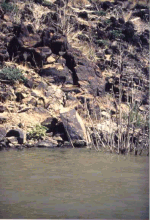 The important thing is to coordinate the rowing with your partner. The person in the bow(front) says “row” and the stern rower synchronizes their paddles. This is the required teamwork which could be called “team building”. The “crashing” of oars can be frustrating and can test the stability of a relationship.
The important thing is to coordinate the rowing with your partner. The person in the bow(front) says “row” and the stern rower synchronizes their paddles. This is the required teamwork which could be called “team building”. The “crashing” of oars can be frustrating and can test the stability of a relationship.
After learning the entry, drive, release and recovery, the concept is to enjoy the wonderful scenery while getting a good workout. Like Nordic skiing, sculling is a full-body sport that uses the muscles of the legs, back, gluts and quads.
This new sport provides access to many canyons in New Mexico where water is too shallow to access by kayak or larger boat. Sculling will open a new world of exploration for you.Mary L. Peachin is a Tucson-based adventure travel writer and photographer. Read about her adventures at test.peachin.com or e-mail her at [email protected].
